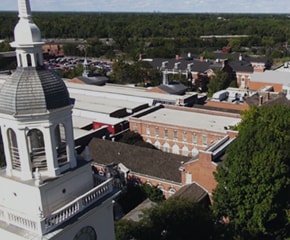
Innovation Journey - Electric Vehicles
17 artifacts in this set
Edison Electric Runabout, circa 1889
Automobile
Thomas Edison had this car built about 1889 to investigate electricity as a power source for automobiles. The three-wheeled vehicle has two electric motors, each separately connected to one of the front wheels. Having successfully operated the car, Edison put it aside for several years. He reactivated the runabout in 1905 to test experimental nickel-iron alkaline batteries.
1896 Riker Electric Tricycle
Automobile
Auto pioneer A.L. Riker built this electric tricycle in Brooklyn, New York, in 1896. Its tubular steel frame, wire wheels, and pneumatic tires are adapted from bicycle practice. Lead-acid batteries are under the seat, and a 40-volt, one-horsepower electric motor powered the rear wheel. Although quite successful at building electric vehicles, Riker sold his company in 1900 and became chief engineer of Locomobile, a builder of high-quality...
Riker Electric Vehicles Sales Catalog, 1900
Trade catalog
The Riker Electric Vehicle Company, formed by inventor Andrew Riker, became known for producing electric touring cars and commercial trucks. This catalog from 1900 shows the company's line of electric vehicles. Riker later developed internal-combustion engines for the Locomobile Company of America.
1901 Columbia Victoria
Automobile
Early automobiles, even electric-powered ones like this 1901 Columbia, looked like carriages. Batteries located over the front and rear axles powered this victoria. The carriage had a 20- to 30-mile range between charges. The owner, Washington Post publisher John McLean, rode in the covered center while his chauffeur steered from behind.
Anderson Electric Car Company Advertisement, "Henry Ford and Thos. A. Edison Buy the Detroit Electric," 1914
Photographic print
Henry Ford and Thomas Edison figured prominently in this 1914 advertisement for the Anderson Electric Car Company. According to the ad, each had owned three electric vehicles -- all Detroit Electrics. The ad also lists other well-known motor company executives who owned Detroit Electrics. Anderson Electric Car Company hoped to parlay these ownership examples into larger sales.
1914 Detroit Electric Model 47 Brougham, Personal Car of Clara Ford
Automobile
Clara Ford, wife of Henry Ford, drove this Detroit Electric. In the years before World War I many women chose electric cars because they started instantly without hand cranking and had no difficult-to-shift transmission. The superintendent of the Detroit Electric factory employed his daughter, Lillian Reynolds, to sell to women -- including Clara Ford, who drove this car into the 1930s.
Battery Charger for Detroit Electric Coupe, circa 1922
Battery charger
Early electric automobiles were clean, quiet and -- with no gears to shift -- easy to drive. But fully recharging their batteries could take anywhere from 8 to 16 hours. Into the 1920s, larger cities often had public charging stations to service electric cars. Owners could also charge their vehicles at home using units like this one.
Letter to Clara Ford from Anderson Electric Car Company, 1915
Letter (Correspondence)
Surprisingly, Clara Ford -- wife of Henry Ford -- drove an electric car instead of a Ford Model T. Early electrics were often marketed to women because of the cars' cleanliness and ease of operation. Anderson Electric, maker of Mrs. Ford's car, sent this letter hoping she might suggest a few friends interested in buying an electric vehicle.
1980 Comuta-Car Electric Runabout
Automobile
The Comuta-Car, and its predecessor the CitiCar, were electric cars designed for limited use in cities. Sharp increases in gasoline prices in the 1970s persuaded some 4,000 people to buy the tiny vehicles. But every time the price of fuel spiked, it always fell again, and demand for specialized urban electrics always fell along with it. Will the time for such cars ever come?
Comuta-Car Sales Leaflet, "I'm Comuta-Car" 1980-1982
Handbill
This handbill, which advertised the Comuta-Car, promoted the electric vehicle's energy savings and pollutions control. These factors, plus fluctuating fuel prices, however, could not convince enough people to purchase these vehicles.
1997 General Motors EV1 Electric Coupe
Automobile
This was the most serious attempt to build an all-purpose electric car since the 1920s. General Motors built 1,117 cars between 1996 and 1999, leasing them to a loyal group that willingly adjusted to battery power's limitations. But GM concluded there were too few electric enthusiasts to support large-scale production and recalled all the cars by the end of 2003. EV1 users objected loudly, but to no avail.
Diagram of a General Motors EV1 Car Chassis, 1997-2002
Photographic transparency
This diagram shows the layout of the General Motors' EV1. Heavy batteries were well distributed to even out the weight, helping the car's handling. The vehicle's range was 70 to 90 miles with special lead-acid batteries exclusive to the EV1. In 1998, GM switched to longer range nickel-metal-hydride batteries.
Cutaway View of a General Motors EV1 Car, 1997-2002
Photographic transparency
General Motors produced the EV1 between 1996 and 1999. The EV1 was the most serious attempt to build an all-purpose electric car since the 1920s. This cutaway view shows the inner workings beneath the body of the vehicle.
2002 Toyota Prius Sedan
Automobile
Hybrid automobiles improve fuel efficiency and reduce tailpipe emissions compared with standard internal combustion-powered cars. Hybrids use small internal combustion engines and battery-powered electric motors. Powerful computers and sophisticated software coordinate the smooth, seamless transfer of power between the two units. This Prius is one of Toyota's first-generation hybrids, introduced in the United States in 2000.
Tesla Car at SpaceX Facility, El Segundo, California, 2008
Digital photograph
Elon Musk, CEO of Tesla Motors and SpaceX, developed (and owned) the Tesla Roadster pictured here. The electric-powered vehicle had the ability to accelerate from 0 to 60 mph in 3.7 seconds, and it could travel 245 miles on a single charge. It was arguably the first viable production electric car of the modern era.
"Tesla Versus Prius" Clip from Interview with Elon Musk, 2008
Film clip
From the idea of "aggregating all of your financial services seamlessly" to multiplanetary existence for the human species, Elon Musk is driven by ideas that propose to fundamentally change the way we live. Building on the financial success of his Internet ventures, the entrepreneur-inventor has gone on to take risk, reward and unconventional thinking to new levels entirely.
2016 General Motors First-Generation Self-Driving Test Vehicle
Automobile
General Motors tested a series of autonomous vehicles in San Francisco, California, and Scottsdale, Arizona, in 2016. These cars, developed with GM subsidiary Cruise Automation and based on the Chevrolet Bolt electric vehicle, used a combination of cameras, radar and lidar sensors, cellular and GPS antennas, and powerful computers to drive themselves on public streets in both cities.
This is user-generated content and does not reflect the views of The Henry Ford.


